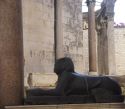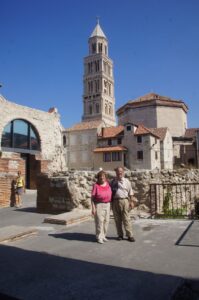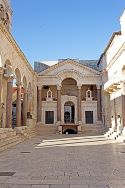July 28, 2013 Split
 We came to Split to get aboard the Athena, our home for the next 11 days. However, I chose this trip partly because Split was one of the places I HAD to visit—it houses (literally) one of the finest Roman ruins of Late Antiquity, the Palace of the Emperor Diocletian.
We came to Split to get aboard the Athena, our home for the next 11 days. However, I chose this trip partly because Split was one of the places I HAD to visit—it houses (literally) one of the finest Roman ruins of Late Antiquity, the Palace of the Emperor Diocletian.
The Emperor, who apparently was born in Illyria (the Roman province we call Dalmatia in honor of one of the first Illyrian tribes to settle here—the Dalmatia, but equally well known for the dogs which Disney made famous!) at what was then the nearby capital, Salona. Inheriting an empire in shambles, Diokles (his Greek name), was quite a warrior. He reconquered Egypt (which accounts for the sphinx in the palace, transported from Thutmose’s tomb, as well as columns from Aswan, used to build the palace), but decided that the empire was too big to succeed, and accordingly, appointed a co-emperor, and two successors. Having stabilized the government, and reorganized the military, after 20 years on the throne, he abdicated as emperor, and got his co-emperor to do the same, elevating the successors as co-emperors of the Roman empire. Until Diocletian, our guide quipped, Rome changed emperors in the late 4th century as often as babies changed diapers.
 He retired to his palace in Split, which he’d spent 10
He retired to his palace in Split, which he’d spent 10  years building, employing 20,000 workers to surround the son of Jupiter (as he was wont to call himself, as the last pagan emperor) with the splendor he had known in Nicomedia (where he was based; it’s near Istanbul). The result was a walled enclosure 750 feet long and 450 feet wide that housed military, religious, administrative, and residential quarters, with 16 gates (3 of which still stand) and a number of towers (none standing). One impressive feature—since he was the emperor, he could not go up and down stairs, so the whole complex—being built on the Adriatic, had to be level, requiring an extensive foundation that has since been excavated, revealing the superior architecture of late Roman antiquity.
years building, employing 20,000 workers to surround the son of Jupiter (as he was wont to call himself, as the last pagan emperor) with the splendor he had known in Nicomedia (where he was based; it’s near Istanbul). The result was a walled enclosure 750 feet long and 450 feet wide that housed military, religious, administrative, and residential quarters, with 16 gates (3 of which still stand) and a number of towers (none standing). One impressive feature—since he was the emperor, he could not go up and down stairs, so the whole complex—being built on the Adriatic, had to be level, requiring an extensive foundation that has since been excavated, revealing the superior architecture of late Roman antiquity.
After his death, some subsequent emperors used the palace, but eventually  a city grew up within, especially using the walls as one of their walls. It is mostly this jumble of medieval and ancient that greets the visitor today; as our guide noted (he was funny!), it’s probably the only 1700 year old ruin where you can see people hanging underwear to dry.
a city grew up within, especially using the walls as one of their walls. It is mostly this jumble of medieval and ancient that greets the visitor today; as our guide noted (he was funny!), it’s probably the only 1700 year old ruin where you can see people hanging underwear to dry.
In other ways, the results were not what Diocletian might have anticipated. He might have been right in anticipating that the Empire, as constituted, was too big to succeed, but his tetrarchy (2 emperors, two successors) might have worked in his reign—a statue of the four looking harmonious, was carted from Constantinople by Crusaders to St. Marks in Venice, where it remains today—but the rise of Constantine and the creation of Constantinople (the new Rome) marked the end of the successful Eastern and Western Emperors. Rome never became the capital again, and the last Western Emperor (by some reckoning), died in the palace in Split in 480. Even Split came, eventually, under Venetian rule, as the Eastern Empire crumbled after 1204, when the 4th crusade got misdirected on its way to Jerusalem, capturing, sacking, and ruling the Byzantine Empire for a half century; Venice took many of the former Byzantine possessions, ruling some areas of the Adriatic until Napoleon ended the Venetian Republic (our Croat guides were bitter about the Italian connection, noting the Venetians forbade the use of Croatian; she added that when Croatians drove out the Germans and Italians in World War II they also destroyed many of the Venetian relics that still remained).
 The biggest irony of Diocletian’s palace, though, involved his mausoleum. Diocletian was buried in the palace. He was also known for his persecution of Christians—many Saints date from his efforts to suppress Christianity. He even executed his wife and daughter when he discovered they had become Christians.
The biggest irony of Diocletian’s palace, though, involved his mausoleum. Diocletian was buried in the palace. He was also known for his persecution of Christians—many Saints date from his efforts to suppress Christianity. He even executed his wife and daughter when he discovered they had become Christians.
When Constantine issued his declaration on tolerance of Christianity, and eventually converted to Christianity, the Christian community in Split eventually (in the fifth century) converted the mausoleum to a church, destroying Diocletian’s sarcophagus, and 200 years later, the mausoleum designed to house the remains of Diocletian, worshipped as a god by the Romans, became a Cathedral, home of the archbishop of Split. It is still in use as a church today. We left just before the mass started this morning.